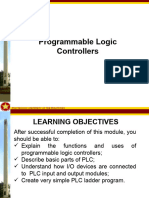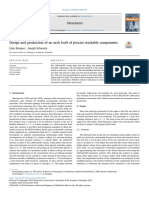Untitled 13
Untitled 13
Uploaded by
Ritesh SharmaCopyright:
Available Formats
Untitled 13
Untitled 13
Uploaded by
Ritesh SharmaOriginal Description:
Copyright
Available Formats
Share this document
Did you find this document useful?
Is this content inappropriate?
Copyright:
Available Formats
Untitled 13
Untitled 13
Uploaded by
Ritesh SharmaCopyright:
Available Formats
Chapter 2 - The Programmable Logic Controller
19.
At what time is data transferred to and from the outside world into a PLC
system?
20.
What common devices may be used to understand the operation of coils and
contacts in ladder logic?
2-18
Chapter 3 - Fundamental PLC Programming
Chapter 3 - Fundamental PLC Programming
3-1.
Objectives
Upon completion of this chapter, you will know
how to convert a simple electrical ladder diagram to a PLC program.
the difference between physical components and program components.
why using a PLC saves on the number of physical components.
how to construct disagreement and majority circuits.
how to construct special purpose logic in a PLC program, such as the oscillator,
gated oscillator, sealing contact, and the always-on and always-off contacts.
3-2.
Introduction
When writing programs for PLCs, it is beneficial to have a background in ladder
diagramming for machine controls. This is basically the material that was covered in
Chapter 1 of this text. The reason for this is that at a fundamental level, ladder logic
programs for PLCs are very similar to electrical ladder diagrams. This is no coincidence.
The engineers that developed the PLC programming language were sensitive to the fact
that most engineers, technicians and electricians who work with electrical machines on a
day-to-day basis will be familiar with this method of representing control logic. This would
allow someone new to PLCs, but familiar with control diagrams, to be able to adapt very
quickly to the programming language. It is likely that PLC programming language is one
of the easiest programming languages to learn.
In this chapter, we will take the foundation knowledge learned in Chapter 1 and use
it to build an understanding of PLC programming. The programming method used in this
chapter will be the graphical method, which uses schematic symbols for relay coils and
contacts. In a later chapter we will discuss a second method of programming PLCs which
is the mnemonic language method.
3-3.
Physical Components vs. Program Components
When learning PLC programming, one of the most difficult concepts to grasp is the
difference between physical components and program components. We will be
connecting physical components (switches, lights, relays, etc.) to the external terminals on
a PLC. Then when we program the PLC, any physical components connected to the PLC
will be represented in the program as program components. A programming component
3-1
Chapter 3 - Fundamental PLC Programming
will not have the same reference designator as the physical component, but can have the
same name. As an example, consider a N/O pushbutton switch S1 named START. If we
connect this to input 001 of a PLC, then when we program the PLC, the START switch will
become a N/O relay contact with reference designator IN001 and the name START. As
another example, of we connect a RUN lamp L1 to output 003 on the PLC, then in the
program, the lamp will be represented by a relay coil with reference designator OUT003
and name RUN (or, if desired, RUN LAMP).
As a programming example, consider the simple AND circuit shown in Figure 3-1
consisting of two momentary pushbuttons in series operating a lamp. Although it would be
very uneconomical to implement a circuit this simple using a PLC, for this example we will
do so.
H1
H3
H2
H4
T1
F1
X1
SWITCH1
X2
SWITCH2
LAMP1
3
PB1
4
PB2
L1
Figure 3-1 - AND Ladder Diagram
When we convert a circuit to run on a PLC, we first remove the components from
the original circuit and wire them to the PLC as shown in Figure 3-2. One major difference
in this circuit is that the two switches are no longer wired in series. Instead, each one is
wired to a separate input on the PLC. As we will see later, the two switches will be
connected in series in the PLC program. By providing each switch with a separate input
to the PLC, we gain the maximum amount of flexibility. In other words, by connecting them
to the PLC in this fashion, we can wire them in software any way we wish.
The two 120V control voltage sources are actually the same source (i.e., the control
transformer secondary voltage). They are shown separately in this figure to make it easier
to see how the inputs and output are connected to the PLC, and how each is powered.
3-2
Chapter 3 - Fundamental PLC Programming
SWITCH1
PB1
PLC
IN1
OUT1
IN2
OUT2
IN3
OUT3
IN4
OUT4
LAMP1
L1
SWITCH2
PB2
120V
CONTROL
VOLTAGE
120V
CONTROL
VOLTAGE
COM
COM
Figure 3-2 - PLC Wiring Diagram for
implementation of Figure 3-1
Once we know how the external components are wired to the PLC, we can then
write our program. In this case we need to connect the two switches in series. However,
once the signals are inside the PLC, they are assigned new reference designators which
are determined by the respective terminal on the PLC. Since SWITCH1 is connected to
IN1, it will be called IN1 in our program. Likewise, SWITCH2 will become IN2 in our
program. Also, since LAMP1 is connected to OUT1 on the PLC, it will be called relay
OUT1 in our program. Our program to control LAMP1 is shown in Figure 3-3.
| IN1
IN2
OUT1
1---| |-------| |---------------------------------------------------------(OUT)|
|
|
Figure 3-3 - AND PLC Program
The appearance of the PLC program may look a bit unusual. This is because this ladder
rung was drawn by a computer using ASCII characters instead of graphic characters.
Notice that the rails are drawn with vertical line characters, the conductors are hyphens,
and the coil of OUT1 is made of two parentheses. Also, notice that the right rail is all but
missing. Many programs used to write and edit PLC ladder programs leave out the rails.
This particular program (TRiLOGI by TRi International Pte. Ltd.) Leaves out the right rail,
but puts in the left one with a rung number next to each rung.
3-3
Chapter 3 - Fundamental PLC Programming
When the program shown in Figure 3-3 is run, the PLC first updates the input image
register by storing the values of the inputs on terminals IN1 and IN2 (it stores a one if an
input is on, and a zero if it is off). Then it solves the ladder diagram according to the way
it is drawn and based on the contents of the input image register. For our program, if both
IN1 and IN2 are on, it turns on OUT1 in the output image register (careful, it does NOT turn
on the output terminal yet!). Then, when it is completed solving the entire program, it
performs another update. This update transfers the contents of the output image register
(the most recent results of solving the ladder program) to the output terminals. This turns
on terminal OUT1 which turns on the lamp LAMP1. At the same time that it transfers the
contents of the output image register to the output terminals, it also transfers the logical
values on the input terminals to the input image register. Now it is ready to solve the ladder
again.
For an operation this simple, this is a lot of trouble and expense. However, as we
add to our program, we will begin to see how a PLC can economize not only on wiring, but
on the complexity (and cost) of external components.
Next, we will add another lamp that switches on when either SWITCH1 or SWITCH2
are on. If we were to add this circuit to our electrical diagram in Figure 3-1, we would have
the circuit shown in Figure 3-4
H1
H3
H2
H4
T1
F1
X1
SWITCH1
X2
SWITCH2
LAMP1
3
PB1
4
PB2
L1
LAMP2
SWITCH1
5
PB1
SWITCH2
L2
PB2
Figure 3-4 - OR Circuit
3-4
You might also like
- The Perfect Sales Script 2.0 Student WorkbookDocument29 pagesThe Perfect Sales Script 2.0 Student WorkbookMemo V.No ratings yet
- Allen Bradley PLC ProgrammingDocument44 pagesAllen Bradley PLC ProgrammingEduardo Luna92% (12)
- PLC Programming from Novice to Professional: Learn PLC Programming with Training VideosFrom EverandPLC Programming from Novice to Professional: Learn PLC Programming with Training VideosRating: 5 out of 5 stars5/5 (1)
- Introduction to the simulation of power plants for EBSILON®Professional Version 15From EverandIntroduction to the simulation of power plants for EBSILON®Professional Version 15No ratings yet
- Basic Steps in PLC ProgrammingDocument5 pagesBasic Steps in PLC ProgrammingHumaid Shaikh100% (2)
- PLC ProgrammingDocument116 pagesPLC ProgrammingVali Ene100% (5)
- Tm240tre.00 EngDocument36 pagesTm240tre.00 EngNanda KumarNo ratings yet
- PLC Programming Using SIMATIC MANAGER for Beginners: With Basic Concepts of Ladder Logic ProgrammingFrom EverandPLC Programming Using SIMATIC MANAGER for Beginners: With Basic Concepts of Ladder Logic ProgrammingRating: 4 out of 5 stars4/5 (1)
- Chapter 3 - Fundamental PLC Programming: H1 H3 H2 H4 T1Document3 pagesChapter 3 - Fundamental PLC Programming: H1 H3 H2 H4 T1Ritesh SharmaNo ratings yet
- MSD Exp3 PDFDocument11 pagesMSD Exp3 PDFSkNo ratings yet
- PLC ProgrammingDocument116 pagesPLC Programmingbryan_robinsonuscNo ratings yet
- PLC Lecture 3Document34 pagesPLC Lecture 3mariam nkoyooyoNo ratings yet
- L-19 (SM) (Ia&c) ( (Ee) Nptel)Document18 pagesL-19 (SM) (Ia&c) ( (Ee) Nptel)Catalin CiubotariuNo ratings yet
- PLC ProgrammingDocument11 pagesPLC ProgrammingRavi JoshiNo ratings yet
- Unit 21799p P.L.C. IIDocument18 pagesUnit 21799p P.L.C. IIcataiceNo ratings yet
- Supplementary Technical Material Programmable Logic Controllers (PLC'S)Document13 pagesSupplementary Technical Material Programmable Logic Controllers (PLC'S)amit_mohanty_2No ratings yet
- PLC ProgrammingDocument117 pagesPLC ProgrammingAhmedEEENo ratings yet
- Programmable Logic Control: Department of Electrical and ElectronicsDocument35 pagesProgrammable Logic Control: Department of Electrical and ElectronicsApurva BangaleNo ratings yet
- MEEN461 - FA17 - LAB01 - Intro To PLCs and LogixProDocument10 pagesMEEN461 - FA17 - LAB01 - Intro To PLCs and LogixProAngel Exposito100% (1)
- PLC and SCADA TRANING REPORTDocument22 pagesPLC and SCADA TRANING REPORTdivesh pandeyNo ratings yet
- Robotics Chapter 8 - PLCsDocument16 pagesRobotics Chapter 8 - PLCstutorfelix777No ratings yet
- PLC Interview Questions and AnswersDocument6 pagesPLC Interview Questions and AnswersJêmš NavikNo ratings yet
- Mechatronics UNIT4&5Document45 pagesMechatronics UNIT4&5saba78% (18)
- Basic Steps in PLC ProgrammingDocument4 pagesBasic Steps in PLC ProgrammingNenad IlicNo ratings yet
- PLC Quick Working ExplainDocument8 pagesPLC Quick Working ExplainMalik SameeullahNo ratings yet
- PLC Lab PDFDocument14 pagesPLC Lab PDFsivaeinfoNo ratings yet
- Me Elective 2-Mechatronics: LECTURE 8 - PLC ProgrammingDocument16 pagesMe Elective 2-Mechatronics: LECTURE 8 - PLC ProgrammingEli James LocabaNo ratings yet
- PLC Unit 2-1 PDFDocument44 pagesPLC Unit 2-1 PDFMahesh ShendeNo ratings yet
- Basics of PLC: S.M. No. Rev. No. Effective DateDocument34 pagesBasics of PLC: S.M. No. Rev. No. Effective DateSUSANTA KUMAR PATRANo ratings yet
- PLC ProgrammingDocument119 pagesPLC Programminginformation & knowledgeNo ratings yet
- 4 PLC ProgrammingDocument49 pages4 PLC ProgrammingAamir Ahmed Ali SalihNo ratings yet
- PLC ExplainedDocument12 pagesPLC ExplainedAntonioNo ratings yet
- 5 PLConlineDocument45 pages5 PLConlineLloyd MontemayorNo ratings yet
- Erickson1996 PLCDocument4 pagesErickson1996 PLCbobleeNo ratings yet
- PLC Programming For Industrial AutomationDocument117 pagesPLC Programming For Industrial AutomationJohn Rey Avena100% (5)
- Basics of PLCs English Version Website Education PDFDocument72 pagesBasics of PLCs English Version Website Education PDFNisar AhmedNo ratings yet
- Creative Technology PLCDocument12 pagesCreative Technology PLCattryr72No ratings yet
- PLC Programming 2Document117 pagesPLC Programming 2tanmoy ghosh100% (2)
- Chapter 4 PLC ProgrammingDocument100 pagesChapter 4 PLC ProgrammingMuhd Izwan Ikhmal RosliNo ratings yet
- PLC Makes Machinery and Systems Work Automatically. Without: The Cost of The Programmer's Time)Document4 pagesPLC Makes Machinery and Systems Work Automatically. Without: The Cost of The Programmer's Time)MCLEAN JOSHUA BERANANo ratings yet
- ELE-2613 Industrial Automation LabManualDocument55 pagesELE-2613 Industrial Automation LabManualSara Alnuaimi100% (1)
- Introduction To Programmable Logic Controllers: What Is PLC?Document16 pagesIntroduction To Programmable Logic Controllers: What Is PLC?Ann RazonNo ratings yet
- PLC 2012Document108 pagesPLC 2012Qais Alsafasfeh100% (2)
- M2 (Mechatronics)Document21 pagesM2 (Mechatronics)Sarah J SinfuegoNo ratings yet
- Programmable Logic ControllersDocument11 pagesProgrammable Logic ControllersLoriedel GondaNo ratings yet
- PLCDocument111 pagesPLCNikhil Srivastava75% (4)
- EI2402-Logic and Distributed Control SystemDocument56 pagesEI2402-Logic and Distributed Control SystemJaibhavani SivajiNo ratings yet
- PLC Programming for industrial automationDocument116 pagesPLC Programming for industrial automationverizenullariNo ratings yet
- PCI - Individual AssignmentDocument10 pagesPCI - Individual AssignmentfarhagharibNo ratings yet
- Industrial Electronics Lab Manual UOCDocument81 pagesIndustrial Electronics Lab Manual UOCImran ShaukatNo ratings yet
- AutomationDocument31 pagesAutomationJerry JosephNo ratings yet
- PLC and SCADADocument77 pagesPLC and SCADAIshwari GhuleNo ratings yet
- PLC Programming ManualDocument117 pagesPLC Programming Manualshek.abhi15No ratings yet
- Learn Digital and Microprocessor Techniques on Your SmartphoneFrom EverandLearn Digital and Microprocessor Techniques on Your SmartphoneNo ratings yet
- Digital and Microprocessor Techniques V11From EverandDigital and Microprocessor Techniques V11Rating: 4.5 out of 5 stars4.5/5 (2)
- PLC Programming Using RSLogix 500 & Industrial Applications: Learn ladder logic step by step with real-world applicationsFrom EverandPLC Programming Using RSLogix 500 & Industrial Applications: Learn ladder logic step by step with real-world applicationsRating: 5 out of 5 stars5/5 (1)
- Hacks To Crush Plc Program Fast & Efficiently Everytime... : Coding, Simulating & Testing Programmable Logic Controller With ExamplesFrom EverandHacks To Crush Plc Program Fast & Efficiently Everytime... : Coding, Simulating & Testing Programmable Logic Controller With ExamplesRating: 5 out of 5 stars5/5 (1)
- PLC: Programmable Logic Controller – Arktika.: EXPERIMENTAL PRODUCT BASED ON CPLD.From EverandPLC: Programmable Logic Controller – Arktika.: EXPERIMENTAL PRODUCT BASED ON CPLD.No ratings yet
- Asus Product Guide: The World's Smallest 13" LaptopDocument23 pagesAsus Product Guide: The World's Smallest 13" LaptopRitesh SharmaNo ratings yet
- Quickstart Manual: Qs-Dsoft32-MDocument40 pagesQuickstart Manual: Qs-Dsoft32-MRitesh SharmaNo ratings yet
- Electrical Engineering Portal ComDocument45 pagesElectrical Engineering Portal ComRitesh SharmaNo ratings yet
- How To Select MCB / MCCB (Part:1) : Electrical Notes & ArticlesDocument4 pagesHow To Select MCB / MCCB (Part:1) : Electrical Notes & ArticlesRitesh SharmaNo ratings yet
- Introduction To PLC Programming and Implementation-From Relay Logic To PLC LogicDocument2 pagesIntroduction To PLC Programming and Implementation-From Relay Logic To PLC LogicRitesh SharmaNo ratings yet
- Calculate Size of Inverter & Battery Bank: Electrical Notes & ArticlesDocument7 pagesCalculate Size of Inverter & Battery Bank: Electrical Notes & ArticlesRitesh SharmaNo ratings yet
- ToshibaDocument316 pagesToshibaRitesh SharmaNo ratings yet
- Introduction To PLC Programming and Implementation-From Relay Logic To PLC LogicDocument2 pagesIntroduction To PLC Programming and Implementation-From Relay Logic To PLC LogicRitesh SharmaNo ratings yet
- PLC PapersDocument5 pagesPLC PapersRitesh SharmaNo ratings yet
- Siemens Pcs 7 TrainingDocument1 pageSiemens Pcs 7 TrainingRitesh SharmaNo ratings yet
- Welcome To The World of Programmable Logic ControllersDocument5 pagesWelcome To The World of Programmable Logic ControllersRitesh SharmaNo ratings yet
- Chapter 8 - Discrete Position SensorsDocument3 pagesChapter 8 - Discrete Position SensorsRitesh SharmaNo ratings yet
- Zendesk - Official Site: Basic PLC Ladder Programming Examples 10Document4 pagesZendesk - Official Site: Basic PLC Ladder Programming Examples 10Ritesh SharmaNo ratings yet
- Design LabDocument76 pagesDesign LabRajath AcharyaNo ratings yet
- Resume CamachooDocument2 pagesResume Camachooapi-384784732No ratings yet
- DisciplineDocument4 pagesDisciplineVerzosa MariaNievaNo ratings yet
- Difference Between Male and Female LanguageDocument3 pagesDifference Between Male and Female LanguageAyesha HameedNo ratings yet
- PHY 107 Experiment 1Document6 pagesPHY 107 Experiment 1Aisha AwaisuNo ratings yet
- L2 V4 02 Datapoints Configuration E 01Document43 pagesL2 V4 02 Datapoints Configuration E 01Rinda_RaynaNo ratings yet
- Mirror HistoryDocument19 pagesMirror Historytanitart100% (1)
- Facility LayoutDocument54 pagesFacility LayoutSimayan Pati100% (11)
- Design and Production of An Arch Built of Precast Stackable Co 2019 StructurDocument7 pagesDesign and Production of An Arch Built of Precast Stackable Co 2019 StructurSteven KuaNo ratings yet
- Issue, Standard and Methods: Presentation Based On Software Project ManagementDocument10 pagesIssue, Standard and Methods: Presentation Based On Software Project ManagementkennedyNo ratings yet
- NTSE 2016 17 Tamil Nadu Answer KeyDocument2 pagesNTSE 2016 17 Tamil Nadu Answer Keysethu pathiNo ratings yet
- imageCLASS LBP6030 - 6030wDocument2 pagesimageCLASS LBP6030 - 6030wagus imamNo ratings yet
- Race For The Galaxy RulesDocument12 pagesRace For The Galaxy RulesJonathan BarelNo ratings yet
- Ethics Exercise LeadershipDocument2 pagesEthics Exercise Leadershipapi-704084699No ratings yet
- CH 13Document32 pagesCH 13hirenpatel_universalNo ratings yet
- Research Proposal: Submitted To: Mr. Sajid Tufail Submitted byDocument5 pagesResearch Proposal: Submitted To: Mr. Sajid Tufail Submitted bymbs_04No ratings yet
- NetAct Monitor and Fault Management ReportingDocument79 pagesNetAct Monitor and Fault Management ReportingJerry SAAGOUON PONKAMNo ratings yet
- Summary of Stress Analysis and Design Qualification of Top End Fitting of AHWRDocument5 pagesSummary of Stress Analysis and Design Qualification of Top End Fitting of AHWRrenu raniNo ratings yet
- Implementation of Biometric Attendance Management System On Cloud EnvironmentDocument3 pagesImplementation of Biometric Attendance Management System On Cloud EnvironmentFlorie-Ann O. RibucanNo ratings yet
- For Web Site Pre Conference CME ScheduleDocument1 pageFor Web Site Pre Conference CME ScheduleNeeraj KancherlaNo ratings yet
- Conservation and Management of Mangroves in OrissaDocument34 pagesConservation and Management of Mangroves in OrissaJitendra Prasad SinghNo ratings yet
- Deep CDocument247 pagesDeep Cdhavala2858No ratings yet
- Shushkewich 1991Document3 pagesShushkewich 1991Mandar SardesaiNo ratings yet
- Carl Sag AnDocument2 pagesCarl Sag AnLiza DawsonNo ratings yet
- Cce PF Cce PR: Subject: Second LanguageDocument10 pagesCce PF Cce PR: Subject: Second LanguageGuruprasad SNo ratings yet
- PART 1 - Describe A PersonDocument11 pagesPART 1 - Describe A PersonPhan ChiNo ratings yet
- Autro Safe Bs310 Commissioning - Handbook - Key1c6Document52 pagesAutro Safe Bs310 Commissioning - Handbook - Key1c6Mohamed Meeran100% (1)
- Coding and Decoding - NewDocument6 pagesCoding and Decoding - Newrishikesh kumarNo ratings yet





































































































